
Concept explainers
A standing wave is described by the wave function
where x and y are in meters and t is in seconds. (a) Prepare graphs showing y as a function of x for five instants: t = 0, 5 ms, 10 ms, 15 ms, and 20 ms. (b) From the graph, identify the wavelength of the wave and explain how to do so. (c) From the graph, identify the frequency of the wave and explain how to do so. (d) From the equation, directly identify the wavelength of the wave and explain bow to do so. (e) From the equation, directly identify the frequency and explain how to do so.
(a)
To draw: The graphs showing
Answer to Problem 18.18P
The graph of
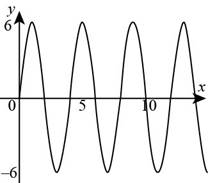
Figure (1)
The graph of
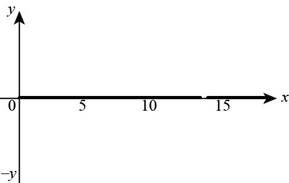
Figure (2)
The graph of
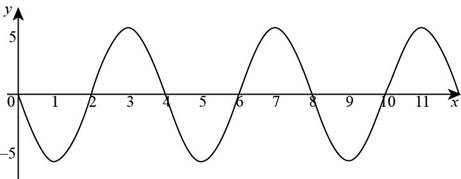
Figure (3)
The graph of
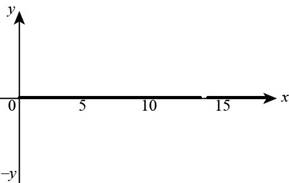
Figure (4)
The graph of

Figure (5)
Explanation of Solution
Introduction:
The values of
Explanation:
Given info: The sinusoidal waves function is,
For
Substitute
The graph of
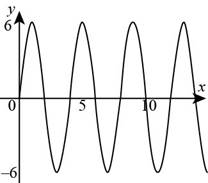
Figure (1)
For
Substitute
The graph of

Figure (2)
For
Substitute
The graph of
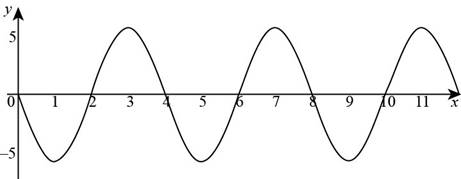
Figure (3)
For
Substitute
The graph of

Figure (4)
For
Substitute
The graph of
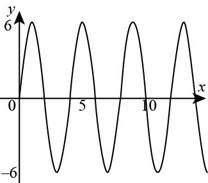
Figure (5)
(b)
Answer to Problem 18.18P
Explanation of Solution
Given info: The sinusoidal waves function is
The distance between the two-crest point or two trough point is called the wavelength of the wave.
From the figure (1), the distance between the two crest point is
Conclusion:
Therefore, the wavelength of the wave is
(c)
Answer to Problem 18.18P
Explanation of Solution
Given info: The sinusoidal waves function is
Compare the equation (1) with
The frequency of the wave is,
Substitute
Conclusion:
Therefore, the frequency of the wave is
(d)
Answer to Problem 18.18P
Explanation of Solution
Given info: The sinusoidal waves function is
Compare the equation (1) with
The frequency of the wave is,
Substitute
Conclusion:
Therefore, the wavelength of the wave is
(e)
Answer to Problem 18.18P
Explanation of Solution
Given info: The sinusoidal waves function is
Compare the equation (1) with
The frequency of the wave is,
Substitute
Conclusion:
Therefore, the frequency of the wave is
Want to see more full solutions like this?
Chapter 18 Solutions
EBK PHYSICS FOR SCIENTISTS AND ENGINEER
- Please help with this physics problemarrow_forwardPlease help me with this physics problemarrow_forwardIn a scene from The Avengers (the first one) Black Widow is boosted directly upwards by Captain America, where she then grabs on to a Chitauri speeder that is 15.0 feet above her and hangs on. She is in the air for 1.04 s. A) With what initial velocity was Black Widow launched? 1 m = 3.28 ft B) What was Black Widow’s velocity just before she grabbed the speeder? Assume upwards is the positive direction.arrow_forward
- In Dark Souls 3 you can kill the Ancient Wyvern by dropping on its head from above it. Let’s say you jump off the ledge with an initial velocity of 3.86 mph and spend 1.72 s in the air before hitting the wyvern’s head. Assume the gravity is the same as that of Earth and upwards is the positive direction. Also, 1 mile = 1609 m. A) How high up is the the ledge you jumped from as measured from the wyvern’s head? B) What is your velocity when you hit the wyvern?arrow_forwardA) If Yoshi flings himself downwards at 9.76 miles per hour to hit an enemy 10.5 m below him, how fast is Yoshi traveling when he hits the enemy? 1 mile = 1609 marrow_forwardNo chatgpt pls will upvotearrow_forward
- No chatgpt pls will upvotearrow_forwardNo chatgpt pls will upvote Alreadyarrow_forwardTwo objects get pushed by the same magnitude of force. One object is 10x more massive. How does the rate of change of momentum for the more massive object compare with the less massive one? Please be able to explain why in terms of a quantitative statement found in the chapter.arrow_forward
- A box is dropped on a level conveyor belt that is moving at 4.5 m/s in the +x direction in a shipping facility. The box/belt friction coefficient is 0.15. For what duration will the box slide on the belt? In which direction does the friction force act on the box? How far will the box have moved horizontally by the time it stops sliding along the belt?arrow_forwardNo chatgpt pls will upvotearrow_forwardNo chatgpt pls will upvotearrow_forward
 Principles of Physics: A Calculus-Based TextPhysicsISBN:9781133104261Author:Raymond A. Serway, John W. JewettPublisher:Cengage Learning
Principles of Physics: A Calculus-Based TextPhysicsISBN:9781133104261Author:Raymond A. Serway, John W. JewettPublisher:Cengage Learning Physics for Scientists and Engineers: Foundations...PhysicsISBN:9781133939146Author:Katz, Debora M.Publisher:Cengage Learning
Physics for Scientists and Engineers: Foundations...PhysicsISBN:9781133939146Author:Katz, Debora M.Publisher:Cengage Learning Physics for Scientists and Engineers, Technology ...PhysicsISBN:9781305116399Author:Raymond A. Serway, John W. JewettPublisher:Cengage Learning
Physics for Scientists and Engineers, Technology ...PhysicsISBN:9781305116399Author:Raymond A. Serway, John W. JewettPublisher:Cengage Learning University Physics Volume 1PhysicsISBN:9781938168277Author:William Moebs, Samuel J. Ling, Jeff SannyPublisher:OpenStax - Rice University
University Physics Volume 1PhysicsISBN:9781938168277Author:William Moebs, Samuel J. Ling, Jeff SannyPublisher:OpenStax - Rice University An Introduction to Physical SciencePhysicsISBN:9781305079137Author:James Shipman, Jerry D. Wilson, Charles A. Higgins, Omar TorresPublisher:Cengage Learning
An Introduction to Physical SciencePhysicsISBN:9781305079137Author:James Shipman, Jerry D. Wilson, Charles A. Higgins, Omar TorresPublisher:Cengage Learning Glencoe Physics: Principles and Problems, Student...PhysicsISBN:9780078807213Author:Paul W. ZitzewitzPublisher:Glencoe/McGraw-Hill
Glencoe Physics: Principles and Problems, Student...PhysicsISBN:9780078807213Author:Paul W. ZitzewitzPublisher:Glencoe/McGraw-Hill





